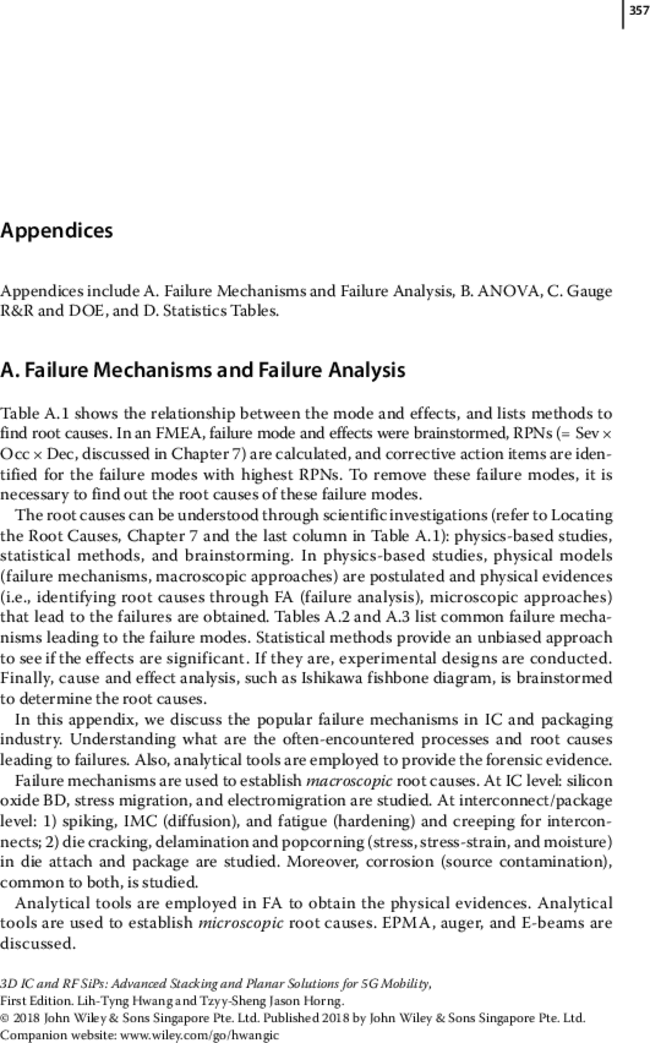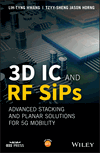Free Access
A. Failure Mechanisms and Failure Analysis
Professor Lih-Tyng Hwang,
Professor Tzyy-Sheng Jason Horng,
Professor Lih-Tyng Hwang
Department of Electrical Engineering and Institute of Communications Engineering, National Sun Yat-Sen University, Kaohsiung, Taiwan
Search for more papers by this authorProfessor Tzyy-Sheng Jason Horng
Department of Electrical Engineering and Institute of Communications Engineering, National Sun Yat-Sen University, Kaohsiung, Taiwan
Search for more papers by this authorBook Author(s):Professor Lih-Tyng Hwang,
Professor Tzyy-Sheng Jason Horng,
Professor Lih-Tyng Hwang
Department of Electrical Engineering and Institute of Communications Engineering, National Sun Yat-Sen University, Kaohsiung, Taiwan
Search for more papers by this authorProfessor Tzyy-Sheng Jason Horng
Department of Electrical Engineering and Institute of Communications Engineering, National Sun Yat-Sen University, Kaohsiung, Taiwan
Search for more papers by this authorFirst published: 31 March 2018

References
- “ Failure Mechanisms,” Chapter 2, Quality and Reliability Handbook, Sony Semiconductor, 2000.
- “ Semiconductor Device Reliability Verification,” Chapter 2, Quality and Reliability Handbook, Sony Semiconductor, August 2011.
- Discussions on electronic failure mechanisms (FMs) and electronic failure analysis (FA) Methods, refer to Section 9 in Electronic Materials Handbook, Vol. 1 Packaging, Merrill L. Minges, ed., ASM International Publishing, p. 958, November 1989.
- J. Klema, R. Pyle and E. Domangue, “ Reliability implications of nitrogen contamination during deposition of sputtered aluminum/silicon metal films,” IEEE-IRPS Proceedings, 1984, pp. 1–5.
- J. T. Yue, W. P. Funsten, and R. V. Taylor, “ Stress induced voids in aluminum interconnects during IC processing,” IEEE-IRPS Proceedings, 1985, pp. 126–137.
- J. W. McPherson and C. F. Dunn, “A model for stress-induced metal notching and voiding in very large-scale-integrated Al-Si (1%) metallization,” J. Vac. Sci. Technology B, 5, p. 1321 (1987).
- J. T. Yue, “ Reliability,” Chapter 12 in ULSI Technology, C. Y. Chang and S. M. Sze, ed., McGraw-Hill, p. 674, (1996).
- J. M. McPherson, “ Accelerated Testing,” in Electronic Materials Handbook, Volume 1 Packaging, Merrill L. Minges, ed., ASM International Publishing, p. 887 (1989).
- D. K. Schroder, “ Reliability and Failure Analysis,” Chapter 12 in Semiconductor Material and Device Characterization, Wiley-IEEE Press, January 2006.
- Electromigration is a phenomenon where the conductor atoms comprising metal wiring move due to impacts with electrons. When current of a certain current density or higher flows continuously through conductor wiring under a high temperature environment, electromigration causes the conductor atoms to relocate, resulting in disconnection (a void) and other defects. Note that this phenomenon becomes more apparent with accumulated operation times, so it is classified as a progressive defect. Electromigration for instance, might be considered a wear-out mechanism. Over time, high current densities in thin-film conductors on integrated circuits can cause voids (depleted) or hillocks (cumulated).
- F. M. d'Heurle, “Electromigration and failure in electronics: An introduction,” Proc. IEEE, 59, October 1971, pp. 1409–1418.
- Jiang Tao, Nathan W. Cheung, and Chenming Hu, “Electromigration characterisitcs of copper interconnects,” IEEE Electron Device Letters, 14(5), May 1993.
- D. Edelstein et al., “ Full copper wiring in a sub-0.25 µm CMOS ULSI technology,” IEEE IEDM, 1997, pp. 773–776.
- F. M. d'Heurle and P. Ho, Thin Films: Interdiffusion and Reactions, John Wiley & Sons, p. 243 (1978).
- T. Uno and K. Tatsumi, “Thermal reliability of gold-aluminum bonds encapsulated in bi-phenyl eoxy resin,” Microelectronics Reliability, 40(1), January 14, 2000, pp. 145–153; A. D. Smigelskas and E. O. Kirkendall, “Zinc Diffusion in Alpha Brass,” Trans. AIME, 171, 1947, pp. 130–142; Ohnishi, M., and K. Fukumoto, “ Diffusion formation of intermetallic compounds on Au-Al Couples by use of evaporated Al films,” Jap. J. Met. Soc., 1974, pp. 38–46.
- G. Harman, Wire Bonding in Microelectronics – Materials, Processes, Reliability, and Yield, second edition, McGraw Hill, 1997; N. Noolu, N. Murdeshwar, K. Ely, J. Lippold, W. Baeslack, “ Phase transformations in thermally exposed Au-Al ball bonds,” Journal of Electronic Materials, 2004; N. Noolu, N. Murdeshwar, K. Ely, J. Lippold, W. Baeslack, “ Partial diffusion reactions and the associated volume changes in thermally exposed Au-Al ball bonds,” Metallurgical and Materials Transactions, 2004; D. Tracy, L. Nguyen, R. Giberti, A. Gallo, C. Bischof, J. Sweet, A. Hsia, “ Reliability of aluminum-nitride filled mold compound,” Proceedings 47th Electronic Components and Technology Conference, 1997, pp. 72–77.
- N. Bertolino et al., “High flux current effects in interfacial reactions in Au-Al multilayers,” Philosophical Magazine B, 82(8), 2002, pp. 969–985.
- https://en.wikipedia.org/wiki/Fatigue_(material)
- Jinhua Mi et al., “ Thermal cycling life prediction of Sn-3.0Ag-0.5Cu solder joint using type-I cencered data,” Scientific World Journal, July 8, 2014.
- D. R. Frear, J. W. Jang, J. K. Lin, and C. Zhang, “Pb-free solder for flip-chip interconnects,” Journal of the Minerals, Metals & Materials Society, 53 (6), 2001, pp. 28–32.
- Vasu Vasudevan and Xuejun Fan, “ An acceleration model for lead-free (SAC) solder joint reliability under thermal cycling,” ECTC 2008.
- N. Pan et al., “ An acceleration model for Sn-Ag-Cu solder joint reliability under various thermal cycle conditions,” SMTA International, September 25, 2005.
- “ Sn-Pb Properties and Models,” NIST Material Measurement Laboratory, see http://www.msed.nist.gov/solder/clech/Sn-Pb_Fatigue.htm#Coffin
- R. Darveaux and K. Banerji, “Constitutive relations for tin-based solder joints”, IEEE Transactions on Components, Hybrids, and Manufacturing Technology, 15(6), December 1992, pp. 1013–1024.
- R. Darveaux, K. Banerji, A. Mawer, and G. Dody, “ Reliability of plastic ball grid array assemblies,” in Chapter 13, Ball Grid Array Technology, ed. J. H. Lau, McGraw-Hill, 1995, pp. 379–442.
- C. Glenn Shirley, “ Plastic package reliability,” ASQ Webinar, Portland State, Portland OR, 2011.
- Lei Mercado and Vijay Sarihan, “Evaluation of die edge cracking in flip-chip PBGA packges,” IEEE Trans. Components and Packaging Technologies, 26(4), December 2003.
- Z. Kornain, Y.C. Ang, Z.Y. Lam, N. Amin, and A. Jalar, “ The investigation of die back edge cracking in flip chip ceramic ball grid array package (FC-CBGA),” Engineering Postgraduate Conference (EPC), Universiti Kebangsaan Malaysia, October 21-22, 2008, page 33.
- “ Plastic ball grid array (PBGA),” AN1231 Motorola Semiconductor Technical Data.
- A. Gallo and R. Munamarty, “Popcorning: A failure mechanism in plastic-encapsulated microcircuits,” IEEE Trans. Reliability, 44(3), September 1995; Gannamani, R. and Pecht, M. G., “An Experimental Study of Popcorning in Plastic Encapsulated Microcircuits,” IEEE Transactions Components, Packaging, and Manufacturing Technology - Part A, 19(2), June 1996, pp. 194–201; Kuo, A. Y., Chen, W. T., Nguyen, L. T., Chen, K. L. and Slenski, G., “ Popcorning - A Fracture Mechanics Approach,” Proceedings 46th Electronic Components and Technology Conference, IEEE Publications, New Jersy, 1996, pp. 869–874.
- A. Aubert, J.P. Rebrasse, L. Dantas de Morais, N. Labat, and H. Fremont, “Failure analysis case study on a Cu/low-k technology in package: New front-side approach using laser and plasma de-processing,” Microelectronics Reliability 50 (2010), pp. 1688–1691.
- “ Sample preparation for transmission electron microscopy,” a PPT by Holm Kirmse, TEM Group, Institute of Physics, Humboldt University of Berlin.



